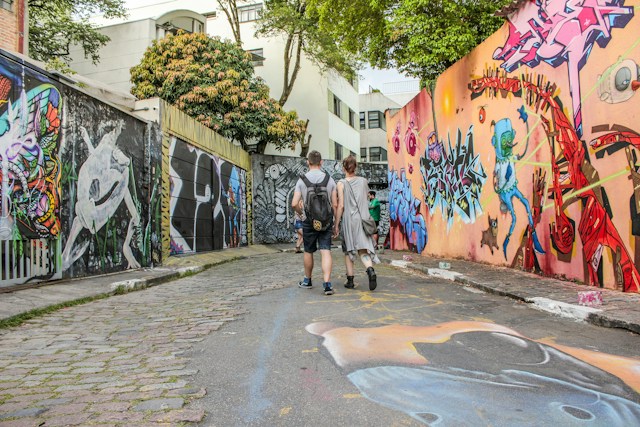Urban art installations and graffiti are often seen as expressions of creativity, rebellion, or social commentary. But can they also serve as a platform for raising awareness and fostering dialogue on public health and social issues? This article delves into the potential of street art as a tool for social change, examining its effectiveness and the challenges it faces.
The Potential of Street Art as a Tool for Dialogue
Urban art installations and graffiti can be seen as a visual language that speaks to the masses. They can tell stories, raise questions, and provoke thought all while being accessible to a large and diverse audience. This makes them a potentially powerful tool for promoting dialogue on societal issues.
A lire aussi : What are the benefits of cold showers for your immune system?
Street art is often a reflection of the society it exists in. It can be a reaction to current events or a response to social, economic, or political issues. By commenting on these issues, street art can raise awareness and stimulate discussion. For instance, Banksy, one of the most famous street artists in the world, uses his art to comment on societal issues like war, poverty, and consumerism. His work often provokes thought and encourages viewers to question the world around them.
Urban art installations, on the other hand, can serve a similar purpose but on a larger scale. With the right placement and message, they can become rallying points for communities, sparking conversations and bringing people together. They can serve as powerful reminders of public health issues, social inequality, or environmental problems.
Dans le meme genre : Can regular involvement in community clean-up and conservation initiatives improve physical pitness and environmental stewardship?
Effectiveness of Street Art in Promoting Public Health and Social Issues
There have been numerous instances where street art has effectively initiated dialogue on public health and social issues. For example, in response to the COVID-19 pandemic, numerous artists around the world created murals expressing solidarity, gratitude to healthcare workers, and reminders of safety measures.
Similarly, graffiti has been used as a tool to shed light on issues like mental health, addiction, and homelessness. The use of public spaces to discuss these issues helps reduce stigma and encourages open conversation.
Fumero, a New York-based artist, uses his murals to depict issues of identity, race, and culture, thereby fostering discussions around these topics.
Street art and graffiti also have the potential to reach a wide audience. Unlike traditional forms of art, which are often confined to galleries and museums, street art is accessible to everyone. This accessibility makes it a powerful medium for raising awareness and initiating dialogue.
However, the impact of street art largely depends on its context and how it is interpreted by viewers. Not all street art is understood or appreciated, and its messages can sometimes be misinterpreted or ignored.
Challenges Faced by Street Artists
While the potential of street art to facilitate dialogue on social issues is immense, it faces numerous challenges. These include legal issues, the temporary nature of the medium, and the potential for misinterpretation or censorship.
Many cities around the world have strict laws against graffiti, viewing it as an act of vandalism rather than an artistic expression. This can restrict artists and limit their ability to engage with public issues through their work.
The temporary nature of street art also poses a challenge. Artworks can be painted over, removed, or damaged, limiting their lifespan and potential impact. This impermanence can make it difficult for street art to sustain long-term dialogues.
Lastly, street art can be subject to misinterpretation or censorship. Given its public nature, street art is open to differing interpretations. While this can spark dialogue, it can also lead to misunderstandings. Similarly, because of its often political or controversial nature, street art can be subject to censorship, further limiting its potential.
The Role of Communities and Policy Makers
For street art to effectively promote dialogue on public health and social issues, support from communities and policy makers is crucial.
Communities can help by appreciating and protecting local street art, and by participating in the dialogues that it provokes. Community involvement can also lend credibility to street art, encouraging more artists to use it as a medium for social commentary.
On the other hand, policy makers can help by recognizing the value of street art and working to integrate it into urban planning. They can also reform laws that view graffiti as vandalism, and instead establish guidelines that allow for its artistic expression.
Furthermore, collaborations between artists, local governments, and non-profit organizations can be a powerful way to use street art for social change. By working together, they can create impactful installations that address public health and social issues, and promote dialogue within communities.
Street art is a powerful tool that has the potential to initiate dialogues on important public health and social issues. With the right support and recognition, it can be harnessed to create a more informed and engaged society. Whether through a graffiti mural on a city wall or a massive art installation in a public park, urban art can foster a culture of dialogue and understanding.
Despite the challenges faced, the potential for urban art installations and graffiti to serve as a platform for meaningful conversation remains largely untapped. Acknowledging the value of this art form and integrating it into our urban spaces could be a significant step towards a more socially conscious society. Therefore, the question is not whether street art can promote dialogue on public health and social issues, but rather, how can we better facilitate and support this dialogue.
Impact on Public Engagement and Perception Change
Urban art installations and graffiti provide a unique and inclusive channel for public engagement. With public health and social issues often being considered complex and hard to approach, the simplified yet insightful messages delivered by street art can be easier to digest for the general public.
This form of art provides a medium through which artists can express their views on various issues, like climate change, mental health, and social inequality, thereby drawing attention to them. This has the potential to alter public perceptions, as the messages conveyed through art can often be more impactful than traditional methods of communication.
Street art also plays a significant role in representing the marginalized sections of society, giving them a voice and making their struggles visible. By highlighting their issues, it can contribute to changes in societal attitudes and inspire empathy among viewers.
For instance, the impactful works of the street artist Swoon focus on social and humanitarian issues, with particular emphasis on marginalized communities. Her pieces have been used to raise awareness about homelessness, addiction, and mental health, sparking dialogue and encouraging a shift in public perception.
However, it’s important to note that the impact on public engagement and perception change largely relies on the interpretation of the viewers. Street art, by nature, is open to wide and varied interpretations and its impact can vary from person to person.
Conclusion
There’s no doubt that urban art installations and graffiti have a unique potential to promote dialogue on public health and social issues. They are a powerful tool that can communicate complex issues to a broad audience in a relatable and impactful manner. Street art can be a voice for the unheard, a spotlight on hidden issues, and a catalyst for change.
However, several challenges stand in the way of fully harnessing this potential. Issues of legality, misinterpretation, and the temporary nature of the art form pose significant hurdles. Yet, with the right kind of support and a shift in perception, these challenges can be overcome.
Communities and policy makers need to recognize the potential of this medium and work towards creating a supportive environment for it. Changes in policy, public support to preserve street art, and increased collaboration between artists, local authorities, and organizations can all contribute to maximizing the impact of street art.
So, as we move forward, the focus should be on how we can better use urban art installations and graffiti as platforms for raising awareness and fostering dialogue on public health and social issues. As the world becomes more urbanized, the role of street art in shaping urban culture and driving societal change is only set to increase.
In conclusion, urban art installations and graffiti have the capacity to be more than expressions of creativity or social commentary. They can serve as powerful platforms for dialogue, understanding, and social change. With the right support and recognition, they hold promise for a more engaged and socially conscious society.











